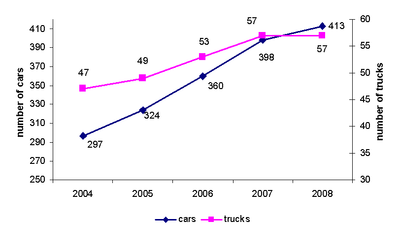Published: 26 Nov 2010
Modified: 17 Feb 2025
In general, the
fall in emissions during the 1990s was due to a decrease in total fuel
consumption caused by the transformation of the national economy, increased energy
efficiency and a switch from solid fuels and liquid fuels to natural gas and
biomass fuels. In recent years, emission levels have remained relatively stable.
The energy sector
is the main source of sulphur dioxide emissions in Latvia.
Domestic heating
and the use of
solvents and other products represent significant sources
of volatile organic compounds (VOCs).
The largest proportion
of nitrogen oxide emissions originates from the transport sector (particularly
road transport) and the number of registered motor vehicles per 1 000
inhabitants continues to increase (Figure 7).
Almost all NH3
emissions originate from agricultural activity.
Overall, air pollution
decreased between 1990 and 2005 − SO2 by 96 %, VOCs by
34 %, and NH3 by 70 % (Figure 8). During this period, the
relative influence of the transport sector on nitrogen oxide emissions grew,
while the influence of energy production fell by almost 50 %.

Figure 7: Number of registered motor vehicles per 1 000 inhabitants
Source: Latvian Environment, Geology and Meteorology Centre
General trend in air
pollutant emissions

Figure
8: SO2, NOx, NMVOC, NH3
emissions, 1990–2008 (1 000 tonnes)
Source: Latvian Environment, Geology and Meteorology Centre

Figure 9: Emissions of particulate matter, 2000–2008 (1 000 tonnes)
Source: Latvian Environment, Geology and
Meteorology Centre
State of the Environment, National Report 2008 [in Latvian]
Sustainable Development Indicators in Latvia 2006 [in
Latvian]
Document Actions
Share with others